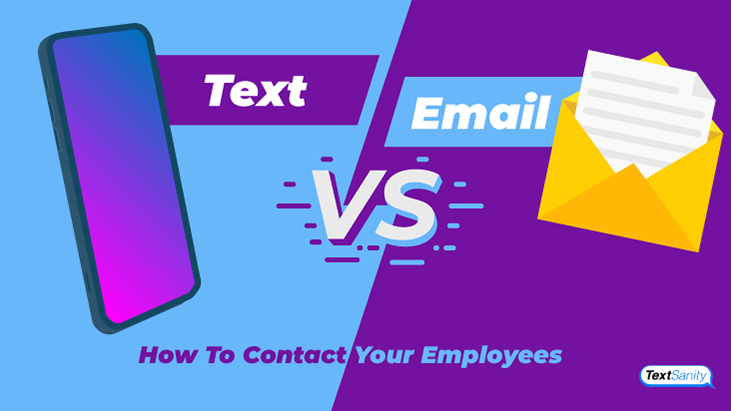Text vs Email: How to Contact Your Employees
Communication is paramount to the success of any relationship. This remains true in the relationship between employees and businesses. Good communication benefits any company. It’s important to understand how to effectively communicate. Knowing when to use text vs email is vital to your business’ success.

Good communication leads to employee engagement. According to Gallup, engaged employees are 59% less likely to seek new employment. Employee retention is important since the cost of high turnover speaks to any level of management.
Another benefit of good communication is mitigating conflict. The majority of conflicts boil down to a lack of communication or an employee feeling misunderstood. This is the result of not understanding how to communicate. So naturally, improving communication leads to less conflict.
Communicating with employees
Good communication with your employees also leads to better relationships with clients. When employees are well-informed and engaged, they communicate better with clients. Plus, employees feel more confident and empowered. This shines through in their interactions with customers.

Improved communication also leads to more productivity and more talent within your workforce. When good communication is present, employees understand expectations. They feel safe expressing their ideas, which unlock innovations that improve your business.
Good communication makes it easier for employees to buyin to the company’s image and ideals. Plus, when you change things, it’s easier to do so with a willing staff.
There are lots of ways to communicate with employees. One example is in-person communication. This is facilitated one-on-one, group, team, or en masse. In-person communication is good for communicating things which require very clear communication or instant feedback. As a rule of thumb, negative information is in-person communication.
Other communication can be handled by phone, memorandum, workplace signage, mail, or intercom. However, two of the most common means of communicating in the digital era is text and email.
Because text and email are so common, it’s important to understand when and how to use them in employee communication. Here’s what you should know about text and email communications with employees.

Rules of communicating by text or email
- Keep it professional. In a perfect world, we’re always professional at work, so this may seem like a no-brainer. However, in text and email, what is digital can never die or be deleted. If you say something by text or email, you need to be able to stand by it forever.

- Grammar matters. Even in the most casual work environment, it’s important to communicate effectively and clearly. Good grammar is essential to getting your message across the way you intend it.
-
Use spell check. As with grammar, spelling is important to communicate your message clearly. If you’re going to take the time to articulate yourself, you don’t want the message muddled.
-
Be clear and concise. Communicate your point clearly. Making your point in a concise manner is important in ensuring the message is read to completion and shows respect for employees’ time.
-
Proofread everything. After highlighting grammar and spelling, proofreading may seem redundant, but it’s important. A quick online search will show a mountain’s worth of embarrassing stories of people who could have protected themselves with a thorough proofreading. Right message and wrong recipient is still a miscommunication.
![]()
Emailing Employees
Email at work is essential. Email is quick, effective, and convenient. Plus, it provides a record of information and communication. You may have even seen a meme or two online that jokes about how most meetings could have easily been an email.

Work email has been mainstream for almost 25 years. After two decades on the job, emails are a preferred way of sending and receiving valuable information at work. This form of communication is part of our work life and is here to stay.
Because it’s such an important communication tool, it’s imperative to know when and how to use email to communicate with your employees. Understanding saves time and improves effective communication.
As you may know, your work emails are the property of the company. And as with anything we put into the digital realm, they last forever. All of this underscores the importance of email professionalism.
If you give information for employee reference frequently, sending it via email saves you from distracting interruptions. When an employee has a question, it gives the employee more confidence when they answer their own questions with the information you provide.
Emails are also important for longer messages. The joke about meetings that could have been an email is funny because it’s true. Hours could be saved by avoiding unstructured meetings that a well-planned email could convey. With email, employees take time to process information when they have time, and employees can reference the information as needed.
Be sure to structure your emails effectively. Some important email tips to remember:
- Include an introduction.
-
Check that attachments work.
-
Be sure all recipients that should get the message are copied.
-
Be cautious when using reply all.
-
Read your emails as if you were the recipient before you send them.
Texting Employees
The first text in the world was sent on December 3rd, 1992. In less than thirty years, cell phone use and texting have grown rapidly. Now, 70% of the earth’s population has a cell phone that can receive text messages.

Texting is so popular that worldwide 23 billion texts are sent each day, and 97% of those texts are opened. Text messaging may be email’s younger sibling, but it certainly doesn’t underperform in comparison.
Because communicating with employees is so important and texting is so prevalent, it’s only natural that texting has evolved into an important part of internal communications for companies. It is quickly becoming a low-cost solution for increasing employee engagement.
Whether you have already begun texting employees or you’ve only begun to think about the possibility, it’s important to know how and when to text your employees. As with anything, there are things to keep in mind when implementing.
How to text employees effectively
- Be brief. It’s called a short message service for a reason. Brevity is key.
-
No feedback. Feedback should be given in person. It’s more personal, and written communication can lose the nuances of direct in-person communication.
-
Use your words. Avoid abbreviations and emojis. These can seem impersonal, and they can be easily misunderstood.
-
No confidential info. Sometimes our systems are pretty fallible, so confidential and private information shouldn’t be sent through text.
-
Know your audience. Don’t text employees in the same way you text your BFF or spouse or family member. They’re easy to send, but that doesn’t mean they can all be casual.
-
Get consent. You should show your employees the same respect that you would show a customer, and always get their consent before you add them to your text database.
-
Don’t overdo it. Be upfront about what you will text your employees about, and tell them when you will text them. Stick to what you said, and be mindful of their off-duty time.
What should you use texting for when it comes to employees depends on your needs as a company. Some examples of things that you can text employees:
- Links to forms or training videos
-
Schedule change updates
-
Meeting reminders
-
Employee feedback surveys
-
Employee incentive
-
Security alerts
There are so many reasons for texting employees, and it might be what takes your communication to the next level in your company.
Summary of text vs email communication
Every company must have a communication strategy for its employees. There are many forms of communication, and most of them have their time and place. Email and text are just two pieces in your communication strategy, but with the right implementation, they can make all the difference.
Knowing when and how to use email and text is so vital to be effective in the digital world we live in. Being professional, positive, and precise with your digital communications will put you on the right path to developing these communication formats as part of your internal communication strategy.


